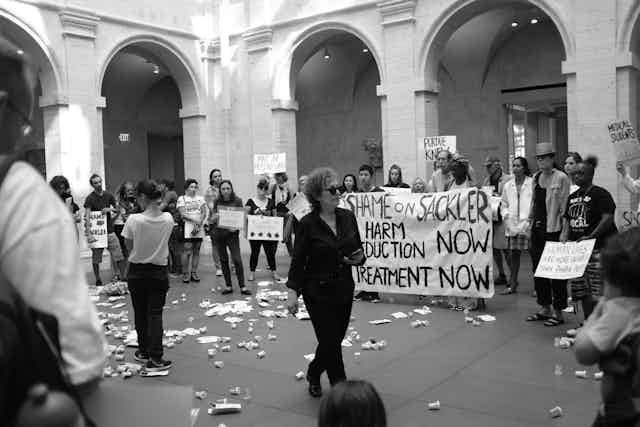The activist group Prescription Addiction Intervention Now, or PAIN, is organizing protests across the country at museums like the Metropolitan Museum of Art’s Sackler wing in New York City, Washington’s Arthur M. Sackler Gallery and the Harvard Art Museums.
These protesters aim to pressure the Sackler family, which amassed a fortune after founding Purdue Pharma – the drugmaker that launched the opioid industry.
As they hurl pill bottles, shout slogans and wave banners, PAIN’s activists are demanding that these institutions scrub the Sackler name from their walls. And they vow to keep the pressure up until the Sackler family and the company that made those billions pay for the cost of fighting opioid addiction.
This campaign is one of the latest examples of how charities can get into trouble when their donors are accused of morally reprehensible behavior. But as a nonprofit law scholar, I have observed that museums, universities and other nonprofits can have trouble distancing themselves from donors who get embroiled in scandals or leave legacies that become an embarrassment.
No pledge is final
When these scandals strike, charities face a dilemma – keep the money given by the now-tarnished donor or return the tainted funds. But returning the funds may be easier said than done.
Once the funds are given, they become committed to charitable use. Returning that money just because the donor’s reputation is now sullied may get the charity in trouble with state regulators.
But if the gift isn’t final, that is not an obstacle.
For example, before allegations regarding sexual abuse – and even rape – by Harvey Weinstein were first reported, the disgraced former Hollywood mogul had a history of supporting feminist causes. Apparently seeking to salvage what remained of his reputation, he sped up his plans to make a US$5 million donation to fund scholarships for aspiring female directors studying at the University of Southern California.
But as several bombshell exposés and lawsuits were on the verge of ending his career, a student started an online petition called on the university to refuse Weinstein’s “blood money.” The school soon rejected the gift, thwarting Weinstein’s effort to cleanse his name through giving.
Naming rights
Charities can have the most trouble distancing themselves from tainted donors when they grant a major giver naming rights: that is, name programs or buildings after them.
Vanderbilt University learned this lesson the hard way when it attempted in 2002 to rename “Confederate Memorial Hall,” a building which it had acquired following a merger with George Peabody College for Teachers in 1979.
Peabody had received a donation of $50,000 from the United Daughters of the Confederacy in 1933 to fund the building’s construction, with the condition that the building carry the moniker in perpetuity.
After Vanderbilt publicly announced that it would remove that tribute to the Confederacy from the building’s name and walls, the organization sued to enforce the terms of its gift agreement.
In 2005, the court ordered the university to reimburse the United Daughters of the Confederacy the value of its original donation, adjusted for inflation, in exchange for the right to rebrand the building.
A decade later, anonymous donors gave Vanderbilt the $1.2 million it took to get rid of what Chancellor Nicholas S. Zeppos called “a symbol of exclusion, and a divisive contradiction of our hopes and dreams of being a truly great and inclusive university.”
Yet some charities opt to maintain the donor’s name despite sullied reputation. Almost 10 years after the Enron scandal broke, the University of Missouri at Columbia appointed its first Kenneth Lay Chair in Economics.
The professorship was established with a gift of $1.2 million in Enron stock from Kenneth Lay, its chairman and CEO, in 1999.
Despite the company’s collapse in 2002, the University of Missouri declined to terminate or rebrand the professorship. Likewise, Northwestern University still maintains a building named after Arthur Andersen, a one-time faculty member and the founder of a huge accounting firm destroyed by the Enron scandal.
Morals provisions
To avoid that kind of headache, naming rights agreements may include what is known as “morals provisions,” arrangements that let charities remove donors’ names from buildings, endowed fellowships or scholarships or return donated funds following allegations of or convictions for immoral or illegal behavior.
In 1988 Bill and Camille Cosby made a $20 million gift to Spelman College, at the time the largest individual donation ever to a historically black college. A portion of the gift was used to endow a professorship at the women’s college bearing the performer’s name.
After allegations of Bill Cosby’s sexual assaults surfaced, Spelman sought to dissociate from its long-standing relationship with the performer. Without a morals provision in place, Spelman initially had to temporarily suspend the professorship.
Eventually, Spelman worked out a permanent solution to terminate the endowed professorship and distribute the related funds to a foundation established by his wife, Camille Cosby.
But it will take more than that to scrub the Cosby name from the school altogether.
Martha Stewart
To be sure, sometimes tarnished celebrity reputations are redeemed to the point where their names don’t become liabilities.
For example, after Martha Stewart spent time behind bars for the obstruction of justice involving a well-timed stock sale, she gave Mount Sinai Hospital $5 million to build a center bearing her name.
The Martha Stewart Center for Living, which aims to increases access to health care for the elderly while improving public perceptions about aging, has kept that branding.

